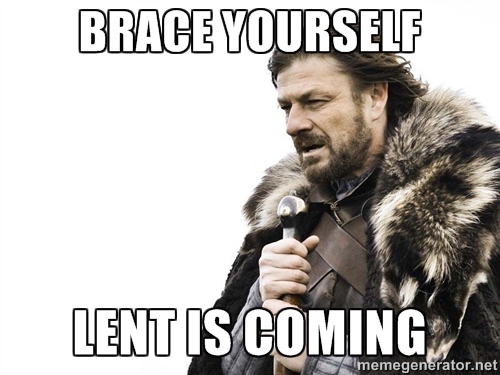You Don’t Have to be the Bad Guy
With two Lego-loving boys in the house, there was little doubt that we would see The Lego Movie. The previews looked cute, but I was pleasantly surprised by how much of the movie I genuinely liked. It was fun, funny, and playful, and you can’t leave the theatre without singing “Everything is Awesome!”
There’s one scene that struck upon a deep theological truth. Short of being a spoiler alert for those who haven’t yet seen it, I’ll simply say that in the battle between good and evil, good wins. It’s not just that good wins, but what happens next. Tucked in to the last moments of the movie is a conversion story, where the protagonist (Emmett) tells the antagonist (President/Lord Business):
The characters take a moment to carefully consider their responses, and of course good wins. But I love how the movie drives home the idea of choice. You don’t have to be the bad guy. You can choose.
In some ways, this scene reminded me of the conversion of Darth Vader in Star Wars: Return of the Jedi. In the battle of good and evil, Luke is convinced that there is still good within his father. The moment of conversion from Darth Vader back to Anakin Skywalker is the unexpected and almost unbelievable climax of the film, which leads to the triumph of good.

So many of the stories we watch and read (and show-to and tell our children) involve good triumphing over evil. It’s rare to see a story of conversion, however. Usually, the bad guys are dismissed as evil and defeated (and often humiliated by the victor).
Yet it’s these stories of conversion that pervade Scripture, particularly as a major theme of Jesus’ teaching.
- Think about the stories you’ve read or movies you’ve watched lately. Are they stories of conversion or defeat-and-dismiss?
Paschal Mystery
Catholics use a lot of words and phrases that we don’t always stop to unpack and explain. One of these is “the Paschal Mystery.” I’m pretty sure that as a child I resigned myself to not understanding what it meant because as it says, it’s a mystery.
The Paschal Mystery refers to the Passion (suffering and death), Resurrection, and Ascension of Jesus.
The very essence of Christian faith revolves around the fact that the suffering and death of Jesus was not the end of the story. Rather, from His death, comes new life–in the Resurrection.
Death is not the end. From death to new life.
It is a mystery because we do not understand how it happens. But it does. And in this mystery we find our salvation: death is not the end.
Moreover, it’s not just something that happened to Jesus. God’s transforming power in the Paschal Mystery happens in our lives every day. We see the cycles of from-death-to-new-life when we recover from brokenness, whether it is physical, emotional, spiritual, or even financial.
In the post Change Anything, Change Everything, I talked about my biggest regret mistake–my failed first marriage. After that marriage ended, I was broken. Shattered. Depressed. Eventually, I picked up the shattered pieces of my life, moved half-way across the country, and with the loving help of my family, an excellent therapist, and the right anti-depressant, I worked on healing and rebuilding. And by the Grace of God, I healed. I grew. I matured. I am not the same person I once was. From-death-to-new-life, the Paschal Mystery is alive in me.
- What are some of your own experiences of death-to-new-life? How is the Paschal Mystery alive in you?
- Where in the Paschal Mystery are you now: the suffering and death of the Passion on Good Friday? The in-between of Holy Saturday? New life in the Resurrection of Easter Sunday?

Lent
Ash Wednesday is around the corner, which marks the beginning of Lent. Lent is a term derived from a word meaning “spring” or “springtime,” the season where we see nature go from death-to-new-life. Like Jesus’ time in the desert, it is a journey of 40 days.
Getting back to Lent… Lent is literally a 40 day period, but since it’s 6 1/2 weeks, it doesn’t look like 40 days on the calendar. There are 46 days from Ash Wednesday and Easter Sunday, but the six Sundays during Lent are not counted because we dedicate Sundays to celebrating the Resurrection.[/info-box]
Ash Wednesday sets us up for this Lenten journey, marking our foreheads with ashes and telling us to “turn away from sin and be faithful to the Gospel.” The focus of Lent, Vatican II reminds us, is Baptism–either preparing to for the Sacrament of Baptism or preparing to take seriously the renewal of our baptismal promises at Easter. Therein, the focus of Lent is conversion. A death-to-new-life, turning away from sin.
Giving Something Up
As a child, I understood Lent as a time to give something up like soda or candy, but in my teen years, this felt very pedantic. It felt like I was approaching Lent as a practice of self-denial so as to suffer. Because Jesus suffered.
The Paschal Mystery is at the heart of our faith, and yes it involves suffering. The Passion of Jesus refers to his suffering and death on Good Friday. That’s an important part of the Paschal Mystery, but the story doesn’t end on Good Friday. With a Paschal Mystery spirituality, Lenten practices are never about suffering for the sake of suffering.
Asceticism is an ancient practice that means self-denial or abstaining from worldly pleasures. (Note that “asceticism” is distinct from the similar sounding “aesthetic” which means beauty.) It is an opportunity to take something that we may be somewhat addicted to (like candy or soda or tv or electronic devices or Facebook), take that obsessive energy and instead direct it towards God. When we find ourselves thinking about (or craving) that “thing,” we are presented with a built-in reminder to focus on God. Ascetic practices serve to open us to new life in God.
Some people choose to take something up or do something positive rather than give something up. In a manner of speaking, a person might give up their “free time” to attend daily mass. But it’s deeper than that. With a Pashcal Mystery spirituality, the aim is conversion; new life in Christ that honors our Baptismal promises.
Perhaps this involves giving up a sinful behavior; reminding ourselves “You don’t have to be a bad guy.” Perhaps this involves intentionally practicing virtuous behavior.
- Is there a Lenten practice that you could do to give up a sinful behavior or take up a virtuous behavior?
The LEGO Movie by Brickset licensed under CC BY 2.0


